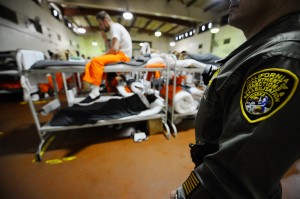Henderson ordered the prison to remove any seriously mentally ill or retarded inmates from the security housing unit. He also appointed a federal monitor to oversee changes in the way California deploys force in prison and how it investigates and disciplines prison staff.
Henderson ended the case with a final three-page written order after the California Department of Corrections and Rehabilitation pledged to keep the reforms even without court supervision. His order was made public Monday.
"The Court is proud of the work done during Advertisement the life of this case. Pelican Bay was once a place where prison officials used force 'for the very purpose of inflicting punishment and pain,'" Henderson wrote, quoting from previous findings in the case.
The judge said he is concerned the department could revert to its previous unconstitutional practices but said he is satisfied that attorneys representing inmates will sue again if the department regresses.
The closing of the case – known as Madrid v. Gomez – is a rare piece of good news for a prison system battling budget cuts and court orders to reduce overcrowding and improve inmate health care.
Matthew Cate, secretary of the California Department of Corrections and Rehabilitation, said ending the litigation affirms the department’s ability to implement key reforms.
“The department has made tremendous efforts over the years to satisfy the court’s orders in this case, resulting in system-wide improvements to medical and mental health care and reforms to CDCR’s internal affairs and disciplinary process,” Cate said. “The court’s decision to terminate this lawsuit means CDCR has successfully complied with the court’s orders to implement reforms of its use-of-force policy, to review and analyze all use of force incidents, to create a process to ensure inmates receive medical and mental health care that meet constitutional standards, and to create an employee investigation and disciplinary process that is fair, consistent and transparent.”
Steve Fama of the Prison Law Office, which filed the original lawsuit, noted a “dramatic difference in the treatment of prisoners” in the decade and a half since Henderson’s ruling.
“When we were litigating Madrid, they were literally killing people on a fairly regular basis with guns,” recalled Don Specter, the Prison Law Office’s director. “That has basically stopped. I have no doubt that a lot of lives have been saved as a result of the case.”
Specter noted one weakness in the Madrid ruling: it didn't outlaw California's use of security housing units--windowless chambers where alleged gang members and other inmates spend nearly all their time locked alone in spartan cells.
"The ruling said that certain inmates with mental illness must be moved out of the units, but others could remain," he said.
Still, disciplinary procedures imposed as a result of the litigation cracked a pervasive code of silence over the use of excessive force by correctional officers, according to Specter.
“No longer could you hide behind the fact that it wasn’t you who was doing it,” he said. “If you saw inappropriate uses of force, you were bound to report it or you yourself were subject to discipline.”
Implementing Judge Henderson’s order has been a long, expensive slog for the prison system. Matthew Cate said he's proud of his department's accomplishments but given the many challenges ahead there isn’t time to look back.
“The hard thing is in this business we don’t have time to celebrate because we’ve got a budget crisis and we’ve knocked out three class actions but there are 16 to go,” he said. “So you take a breath, you shake hands and you get right back to work.”
You can listen to KQED Reporter Kelly Wilkinson talk with Michael Montgomery about the end of the case.
